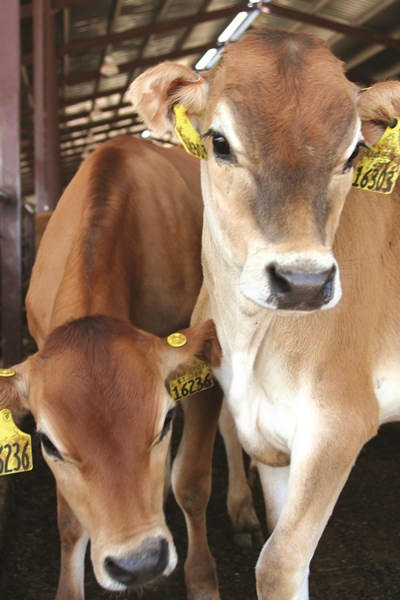In Command of a Crisis

Experts are working to secure the nation’s milk supply in case of a foot-and-mouth disease outbreak
 |
If foot-and-mouth disease were detected in the U.S., a national animal health emergency would be declared. In the dairy industry, restrictions would be placed on the movement of cattle, and exports of dairy products would stop. |
If an outbreak of foot-and-mouth disease (FMD) were to occur in the U.S., would milk continue to move safely and without interruption from dairies to processing plants to consumers?
Pam Hullinger, a University of California-Davis (UC Davis) scientist, wants to make sure that it does. She is part of a national team of experts working to ensure that the U.S. has a viable plan in place in case the dreaded disease ever appears in this country.
That Secure Milk Supply team—involving USDA and other federal and state agencies, academia and allied industry—knows that an FMD diagnosis would create a national animal health emergency. Not only would the highly contagious disease severely impact the daily activities and economic viability of all livestock sectors, but more specifically, it would likely disrupt the flow of milk for processing and dairy product deliveries.
Hullinger and her colleagues are collaborating on a Secure Milk Supply crisis readiness program. Their goal is to ensure that, during an FMD crisis, dairy producers and processors maintain business continuity, minimize disease spread and assure a steady supply of milk and dairy producers to consumers.
Their readiness efforts involve developing pre-outbreak risk-based plans, guidelines, outreach and training to protect the nation’s dairy industry. The team is part of a broader Secure Food Supply effort that’s also working to protect the U.S. pork, egg, turkey and broiler supplies in case of an FMD or avian influenza outbreak. USDA’s Animal and Plant Health Inspection Service (APHIS) funds the program.
Bonus Content | |
| Dry cow study and Web resources:
|
"The North American animal agriculture industry is unique," says Hullinger, who is with the Department of Veterinary Medicine and Epidemiology at the UC Davis School of Veterinary Medicine. "The size, structure, efficiency and extensive movement inherent in the North American livestock industries will present unprecedented challenges in the event of an FMD outbreak."
FMD affects all cloven-hooved animal species: cattle, sheep, pigs and goats. It does not affect humans, although it’s sometimes confused with the hand, foot and mouth disease that’s often found among young school children. FMD belongs to the large picornavirus family, with several strains and sub-strains. Symptoms are high fever, followed by blisters in the mouth and on feet and teats; quick loss of milk production and drooling in cattle. The disease is spread by direct contact between infected animals and on equipment or inanimate objects, such as truck tires. It’s also believed that aerosol transmission may play a role in FMD’s spread. Low mortality is seen in adult animals, but it’s high in juveniles. Adult animals can recover.
The U.S. has seen nine FMD outbreaks, the last in 1929. But the disease has since erupted in other countries, notably in Taiwan in 1997; Great Britain in 2001 (when 10,000 farms were depopulated) and again in 2007; Uruguay in 2001; Japan in 2010; South Korea, Bulgaria, Turkey and Israel in 2011; and Egypt in 2012. FMD costs reached $16 billion in Great Britain and $3 billion in South Korea.
Hullinger says scientists have learned these lessons from those past FMD outbreaks:
- Early recognition, reporting and detection are always key.
- Effective biosecurity is key to minimizing the extent and controlling spread of the disease. "The better routine biosecurity is, the less FMD will spread prior to detection," she says.
- When necessary, early implementation of vaccination is critical to success.
"We must plan now and be prepared to respond in new ways," Hullinger says.
Traditional FMD responses have involved mass herd depopulation, disposal and disinfection. But those no longer offer a practical approach for large outbreaks, given the modern animal husbandry systems of concentrated herds, the vast global mobility of animals and commodities, and the speed of commerce, says Darrel Styles with USDA-APHIS Veterinary Services Emergency Management.
Instead, a modern FMD response would entail a broader approach of detecting, controlling, mitigating and containing the disease quickly.
"People often ask, ‘Why don’t you just go ahead and vaccinate for FMD?’" Styles says. "No. 1, that would destroy our export market. No. 2, we can’t anticipate what strain of FMD we might be challenged with."
Because vaccination resources are likely to be limited, an FMD response would focus on managing animal movement, establishing control zones, administering vaccines strategically and even allowing affected animals to endure the disease until they recover.
For now, the Secure Milk Supply program is engaging stakeholders and developing guidelines in its planning process for an FMD response. What’s important today is that dairy stakeholders begin to work with animal health officials and other key players on contingency plans in their states and regions.
"Pre-event planning is critical to maintaining dairy industry viability while controlling FMD," Hullinger says.
 |
Recent estimates indicate that endemic countries around the world spend $6.5 billion to $21 billion annually in an attempt to prevent and manage the severe impacts of foot-and-mouth disease in their livestock populations, says Pam Hullinger, scientist at University of California Davis. |







